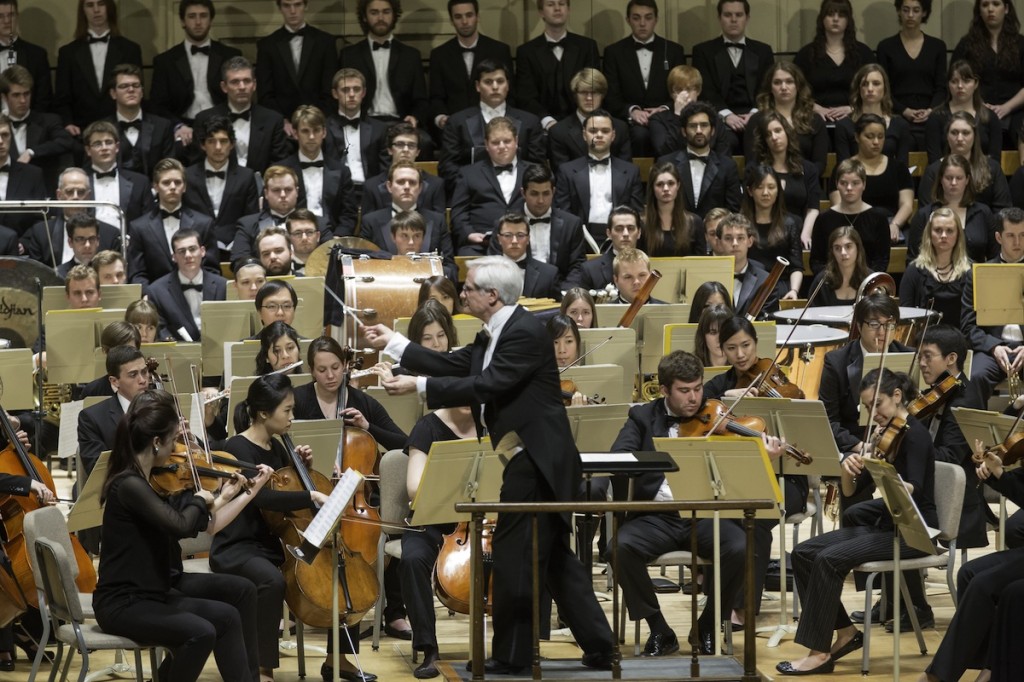BU Symphony brings stirring life to Hindemith’s rarely performed Requiem

David Hoose conducting the BU Symphony Orchestra and Chorus in Hindemith’s Requiem Tuesday night. Photo: Michael Lutch
In what turned out to be a program well suited for Memorial Day, the Boston University Symphony Orchestra and Chorus offered a concert of intense, meditative music at Symphony Hall Tuesday night.
Three works—a traditional hymn, a reflective Ives tone poem, and a little-heard Requiem by Hindemith—showcased the BU orchestra and chorus in top form as they explored themes of springtime and death. Conductor David Hoose, guided the way with a steady hand.
To open, the ensembles paired, without pause, Hoose’s own pensive setting of For those we love within the veil and Ives’ Decoration Day.
It proved an effective combination. Both pieces memorialize fallen comrades: the hymn thanks God “for they have won to cloudless day” while the Ives, through descriptive music, recalls a parade of lilacs, daisies, and peonies during a small town Memorial Day service.
Hoose’s arrangement featured sparse wind calls that pepper the texture with terse, Ives-like dissonances as the melody slowly unwound in hushed, haunting tones from the chorus. Ives’ Decoration Day, the second movement from his Holidays Symphony, is equally somber, and the orchestra maintained fine balance maneuvering the light polytonal lines that shadow quotations of “Second Regiment,” and “Nearer my God to thee.” The orchestra filled the hall with the raucous quotation of the march tune at piece’s close.
For those we love provided yet another link to concert’s main course, Hindemith’s Requiem.
An hour-long exploration for chorus, orchestra, and soloists of Walt Whitman’s When Lilacs Last in the Door-yard Bloom’d, the Requiem is a thought-provoking work that lays bare the subject of death.
In 1946, Hindemith set Whitman’s ode to Abraham Lincoln to commemorate both the passing of American soldiers in World War II and the death of another president, Franklin Delano Roosevelt. A fitting quotation of For those we love appears as a lamentation for strings in the eighth of the eleven movements.
Soloist James Demler’s lyrical baritone brought sweetness to Hindemith’s chant-like vocal lines, especially in “And I knew death.” Mezzo-soprano Penelope Bitzas sang with a dark-colored tone that sounded fullest in her middle range, particularly in the pastoral “Sing on, there in the swamp.”
But despite the singers’ efforts, the music itself suffers from ponderous moments. That was in large part due to the declamatory and narrative nature of Hindemith’s text setting. The score’s dramatic shape is terraced rather than arched, and the limited expressive opportunities posed a considerable challenge for Demler and Bitzas to shape the text for the long stretch.
But the piece has plenty of excitement too. The BU Symphony Orchestra, with crisp sound and punching brass, supplied dramatic power to the accompanying hulking chords and motoric rhythms. And the BU Symphony Chorus performed with clean diction and tone that rose to the heights in the central verse “Lo! The most excellent sun.” The high-energy moments fitfully presented balancing issues as the chorus and soloists were sometimes lost beneath waves of heavy orchestration.
Criticized after its premiere for its austerity, Hindemith’s “Lilacs” Requiem could benefit today from repeat performances. Kudos to Hoose and the Boston University forces for bringing this difficult and contemplative work to life.
The BU School of Music, Opera Institute, and School of Theater will present Mozart’s La Clemenza Di Tito at the Boston University Theatre 7:30 p.m. April 18, 19, 20, and 2 p.m. April 21. bu.edu/cfa
Posted in Performances